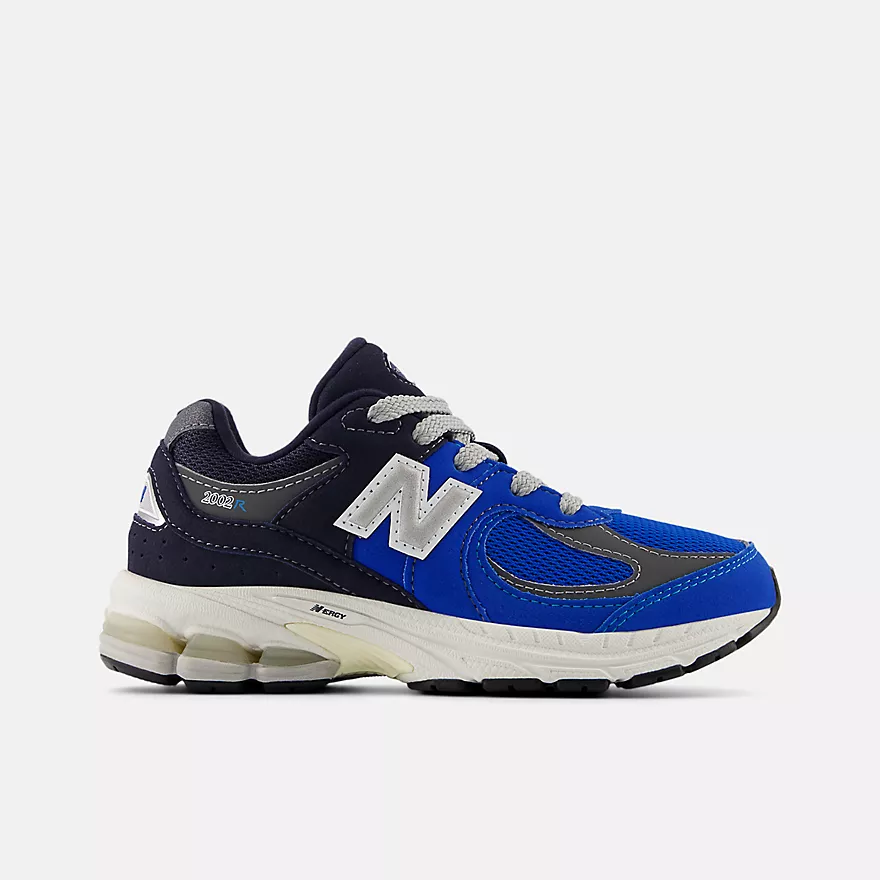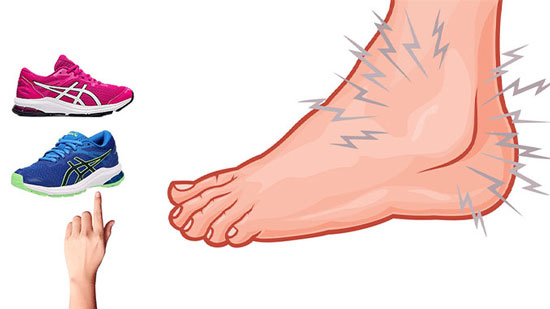How to Treat the Sprained Ankle in Kids – Let me Show you the Most Supportive Shoe Styles!

Do you have a child who sprained his/her ankles? Did you know that an ankle sprain is a common injury in children? The most effective way of how to treat the sprained ankle in kids is to ice and rest the foot, and if there is no broken bone, allow your child to put weight on the ankle. If your child is ready to put weight on the ankle, you must make sure that your child wears shoes that fit well and support the ankles properly.
Wearing the correct type of shoes can prevent this condition from happening and they are also the best treatment if the condition is already present. I believe that the type of shoes that you provide for your child plays a key role in preventing ankle sprains. However, if you provide your child with the wrong pair of shoes, then they can be a contributing cause to the problem.
Children are always running around and involved in high-impact activities, so you need to provide them with shoes that provide good support, cushioning, traction, and protection from the punishing effects of hard surfaces. If your kids are involved in sports, then they are stressing their feet and legs at a whole different level.
I always recommend parents to be proactive and don’t take the “wait and see approach” when it comes to treating their children’s foot conditions. Leaving your children’s foot conditions untreated can only lead to the condition getting worse.
Are High-Top Shoes More Supportive than Regular Sneakers?
I want to clarify that high-top shoes don’t necessarily provide better support than regular sneakers. The first and most important feature that we must find in your kids’ shoes is a firm heel counter. Do you know what the heel counter of the shoe is? It’s the back part of the shoe that provides ankle support and below you can see an image for clarification:
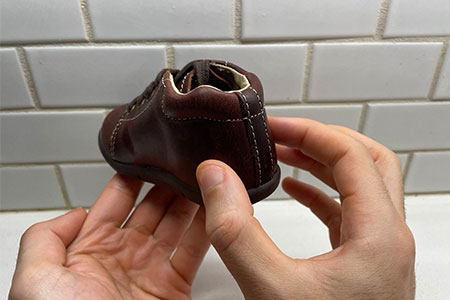
We always want the heel counter of the shoes to be firm, as the firmer it is, the better ankle support it provides. A firm heel counter also helps prevent your kids’ ankles to move too much inside the shoes. The image below shows the difference between a shoe with a firm heel counter versus a shoe with a softer one:
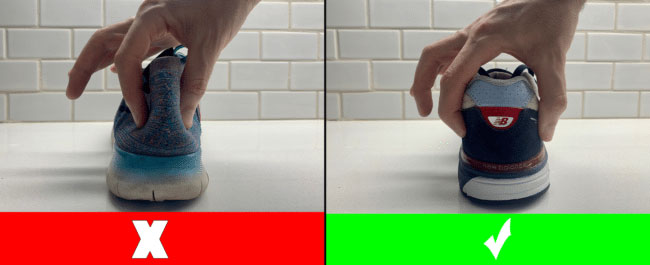
I will show you how to treat the sprained ankle by providing you with a selection of the best children’s shoes that provide a substantial outsole and a firm heel counter.
Signs and Symptoms of an Ankle Sprain – Take Note!
If you notice that your child is having a hard time walking, mild to severe pain around the ankle area, or less movement in the ankle, then it’s very likely that your child has a sprained ankle.
Has your child been complaining about ankle pain? Pay close attention to any of these signs:
- Swelling and bruising around the front and side of the ankle.
- Tenderness around the areas of the bones.
- Little or no tenderness over the bony prominences.
There are a couple of simple methods that you can start taking at home as soon as your child has sprained his or her ankles:
- Rest the ankle for the first 24 hours.
- Put ice packs onto the swollen or sore area for 30 minutes every four hours for three days.
- Raise your kids’ ankle above the level of the heart to help reduce the swelling.
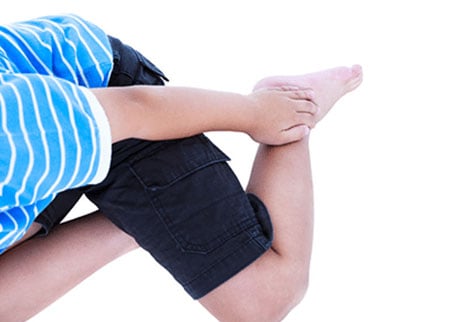
The Best Shoes to Treat and Prevent Ankle Sprains – 4 Key Features!
There are 4 important features that your kids’ shoes must provide to provide your child with good support around the arch and ankle area:
1️⃣ Supportive Outsoles: A shoe that provides the correct amount of support helps minimize the impact that your kids’ feet take every time they come in contact with the ground. When children are running or jumping their feet take a beating, and the ankles are one of the areas that get affected the most. Let me show you the difference between a shoe that provides good support versus one that doesn’t:
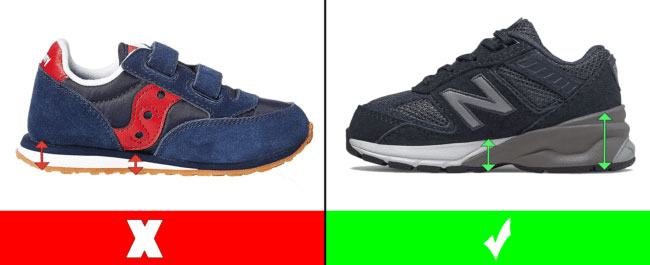
2️⃣ Flexible and Lightweight: The shoes must be supportive but lightweight and flexible at the same time to prevent your kids’ feet and legs from easily getting tired. Your kids’ shoes should always bend at the ball of the foot but no further.
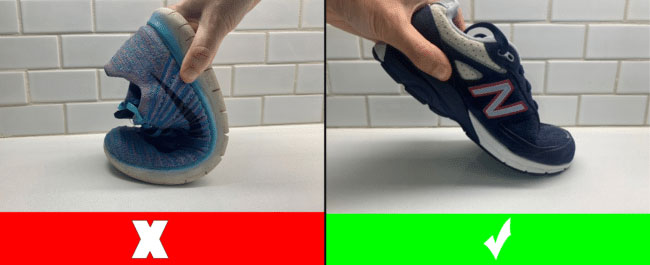
3️⃣ Firm Heel Counters: We already went over this feature at the beginning of the article. Here is the image again just in case:

4️⃣ Shoelaces vs Velcro: I always recommend parents provide their children with shoelaces instead of velcro closure, especially if you want to prevent sprained ankles. Shoelaces will hug your kids’ ankles and allow your child to get full support from the shoes. They will also reduce any remaining gap between your kids’ feet and the shoes.
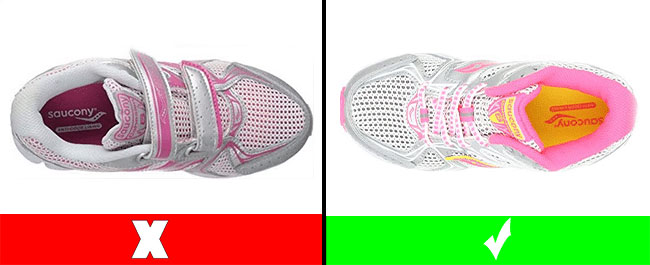
Can we find a pair of shoes for your child that provides all of these features? Yes, we can! I have fitted shoes with all of those features before and I will show them to you shortly. Before I show you that list, I want to make sure that you know what shoe size you should order for your child.
Are you 100% Sure of Your Child’s Foot Size? – Let’s Find Out!
Keep in mind that the shoes must fit the shape of your child’s feet perfectly, which involves getting the correct shoe length and the correct shoe width. It’s extremely important for the shoes to not be too wide or loose around the ankles, as too much ankle movement can lead to injuries and foot issues.
This is the reason why I always recommend parents take their kids to be properly fitted for shoes at their local shoe store, where a shoe fitter can properly measure their feet and find shoes that fit. The issue is that most parents don’t have a local kids’ shoe store that they trust and must end up purchasing their kids’ shoes online.
Let’s first start by checking if you have a good-fitting children’s shoe store in your area. You can do this by taking a look at a resource I created where I describe the best-fitting children’s shoe stores by state.
How to Order the Correct Shoe Size Online
If you don’t have a children’s shoe store in your area, then take a look at a different article where I describe the simplest, yet most effective way to figure out your child’s foot size from home. In that article I help parents determine their child’s exact foot size and whether the child has narrow, medium, wide, or extra wide feet. I also will be able to tell you whether your child has a high instep or not.
Now that you know what features the shoes I recommend provide and how to figure out your child’s foot size from home, you are ready to see a selection of the best shoes for a child with a sprained ankle.
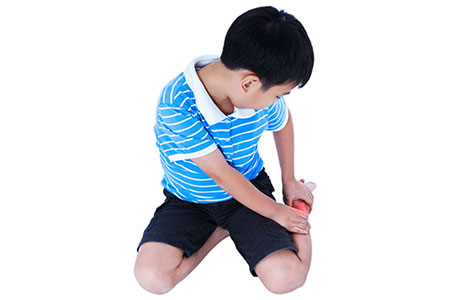
Keep in mind that all of the shoes I recommend are shoe styles that I have fitted before and I have tested the quality and support that they provide, as that is the only way for me to also tell how the shoe fits. Disclosure: Some links in this post may be affiliate links and we may receive a small commission (at no extra cost to you) when you click our links and make purchases.
The Best Shoes to Help Treat and Prevent Sprained Ankles
Below you can find a selection of the best kids’ shoes to prevent and treat sprained ankles. These shoes can fit children with narrow, medium, wide, or extra wide feet.
Little Kid Shoe Sizes (10.5 to 3)
- New Balance shoe style 2022
- Available in medium and wide widths
- Durance rubber outsole technology provides superior durability in high-wear areas to help get more out of the shoes
- Non-marking outsole
- Order this shoe a whole larger than your child’s current foot size
- New Balance shoe style 2022
- Fits children with medium or wide feet
- Durable leather/suede mesh upper
- Stability Web outsole technology provides added arch support
- Order this shoe a half size larger than your child’s current foot size
- Shoe style Axon by Saucony
- Available in medium and wide widths
- EVA midsole provides increased shock attenuation, responsive cushioning and lasting durability
- Cushioned footbed
- Order this shoe a whole size larger than your child’s current foot size
- Shoe style Axon by Saucony
- Available in medium and wide widths
- EVA midsole provides increased shock attenuation, responsive cushioning and lasting durability
- Padded tongue and collar
- Cushioned footbed
- Order this shoe a whole size larger than your child’s current foot size
- New Balance shoe style Fresh Foam 880V12
- Available in medium and wide widths
- Dual-layer midsole construction featuring top-bed foam cushioning and underfoot Fresh Foam X
- Order this shoe half a size larger than your child’s current foot size
- New Balance shoe style Fresh Foam 880V12
- Available in medium and wide widths
- Lace-up closure
- Strong rubber outsole and cushioned midsoles
- Order this shoe half a size larger than your child’s current foot size
- Asics shoe style GT-1000
- Fits narrow and medium feet
- Supportive leather and mesh upper for breathability
- Firm heel counter
- Supportive outsole
- Order this shoe a half size larger than your child’s current foot size
- Asics shoe style Contend 8
- Fits narrow and medium feet
- Lace-up closure
- Firm heel counter with supportive outsole
- Removable insoles
- Order this shoe a whole size larger than your child’s current foot size
- Asics shoe style Contend 8
- Fits narrow and medium feet
- Removable Insoles
- Order this shoe a whole size larger than your child’s current foot size
- New Balance shoe style 1440v1
- Available in medium and wide widths
- Lightweight EVA foam cushioning in the midsole and padded heel increases comfort
- Firm heel counter
- Supportive heel for active kids
- Order this shoe a half size larger than your child’s current foot size
- New Balance shoe style 1440v1
- Fits medium and wide feet
- ABZORB midsole absorbs impact through a combination of cushioning and compression resistance
- Leather/mesh upper
- Order this shoe half a size larger than your child’s current foot size
- New Balance shoe style 1906
- Fits medium and wide feet
- Breathable mesh and synthetic upper
- Heel grid system for stable cushioning in the heel
- EVA midsole provides increased shock attenuation, responsive cushioning and lasting durability
- Order this shoe half a size larger than your child’s current foot size
Big Kid Shoe Sizes (3.5 to 7)
- New Balance shoe style 527
- Available in medium and wide widths
- Supportive outsole with firm heel counter
- Lightweight and flexible
- Order this shoe a whole size larger than your child’s current foot size
- New Balance shoe style 527
- Available in medium and wide widths
- Supportive outsole with firm heel counter
- Lightweight and flexible
- Order this shoe a whole size larger than your child’s current foot size
- New Balance shoe style FuellCell Propel
- Available in medium and wide widths
- Dual-layer midsole construction featuring top-bed foam cushioning and underfoot Fresh Foam X
- Order this shoe half a size larger than your child’s current foot size
- New Balance shoe style FuellCell Propel
- Available in medium and wide widths
- Dual-layer midsole construction featuring top-bed foam cushioning and underfoot Fresh Foam X
- Order this shoe half a size larger than your child’s current foot size
- Adidas style Hoops Mid 3.0
- Fits children with medium or wide feet
- Strong rubber outsole and a cushioned midsole
- Order this shoe a half size larger than your child’s current foot size
- Asics shoe style Gel-Cumulus 25
- Fits narrow and medium feet
- Removable Insoles
- Order this shoe a whole a size larger than your child’s current foot size
- Asics shoe style GT-1000 12
- Fits narrow and medium feet
- Removable Insoles
- Order this shoe a whole a size larger than your child’s current foot size
- New Balance shoe style Dynasoft 520
- Fits medium and wide feet
- ABZORB midsole absorbs impact through a combination of cushioning and compression resistance
- Lightweight mesh upper
- Order this shoe half a size larger than your child’s current foot size
- New Balance shoe style Dynasoft 520
- Fits medium and wide feet
- ABZORB midsole absorbs impact through a combination of cushioning and compression resistance
- Lightweight mesh upper
- Order this shoe half a size larger than your child’s current foot size
- New Balance shoe style Fresh Foam 1080 v13
- Available in medium and wide widths
- Strong rubber outsole and cushioned midsoles
- Suede/mesh upper provides durability and breathability
- Order this shoe half a size larger than your child’s current foot size
- New Balance shoe style 2022
- Available in medium and wide widths
- ABZORB midsole absorbs impact through a combination of cushioning and compression resistance
- Durable leather upper
- Stability Web outsole technology provides added arch support
- Order this shoe a half size larger than your child’s current foot size
- Shoe style Axon by Saucony
- Available in medium and wide widths
- EVA midsole provides increased shock attenuation, responsive cushioning and lasting durability
- Cushioned footbed
- Order this shoe a whole size larger than your child’s current foot size
- Shoe style Axon by Saucony
- Available in medium and wide widths
- EVA midsole provides increased shock attenuation, responsive cushioning and lasting durability
- Padded tongue and collar
- Cushioned footbed
- Order this shoe a whole size larger than your child’s current foot size
The Importance of Lacing Your Kids’ Shoes Correctly
I want to expand a little more on the importance of tying your child’s shoes properly. There is actually a specific shoe tying technique that if done correctly will secure your kids’ ankles by pushing them against the back of the shoe, and filling any remaining gap around that area, this will also reduce ankle movement and prevent injuries.
Are Any Other Shoe Choices Available?
Do not hesitate to contact me directly via my e-mail if you have any further questions or if your child happens to have narrow feet and you need different shoe recommendations. My e-mail address is:
If you noticed that your child’s ankles are swollen, then you must take action before the issue escalates. Just so we are on the same page, an ankle sprain can be defined as an injury in which the ligament in the ankle is stretched or torn. Your kids may have twisted their ankles playing sports or landed on their feet in a strange way to cause this injury.
Now that you know how to treat the sprained ankle you can keep your kids’ feet and legs healthy!
Do you have a child with a sprained ankle? Is there a particular shoe style that you have tried that has worked well for your child’s feet? Please share your findings below so other parents can benefit from your experiences.

